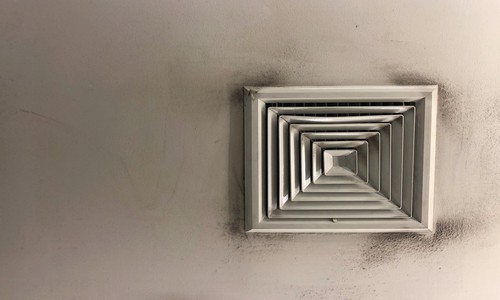You might be sitting on your sofa one night, looking around your front room, only to notice a patch of what looks like black spots and dust around the air vent. Upon closer inspection, you notice that the black spots are circular in nature, and in fact, patches of mold.
Black mold in and around your air vents is unattractive to look at, but also has the potential to cause health issues if not dealt with quickly. In this article, I will explain exactly what you need to do to clear your air vents of mold and how to prevent it from coming back, so keep reading!

What is black mold?
Black mold (Stachybotrys chartarum), is a strain of fungus that can produce toxic compounds known as mycotoxins. These can cause respiratory symptoms such as coughing, breathlessness, and, irritation of the eyes and nose. It can also bring on asthma attacks to those sensitive to the spores it produces.
It is commonly found in damp, dark areas where is a constant source of organic matter it can feed on.
Signs and symptoms of black mold in your ventilation systems
One of the more obvious symptoms of mold accumulation within a ventilation system is a strong, musty odor when the unit is activated.
You may also see small black splotches (usually in a circular formation), around the edges of supply vents.
If you are prone to allergies and notice that your symptoms become worse each time your unit is activated, it may be a signal that you have mold growth in or around your ventilation system.
It’s a good idea to inspect your air vents (both internally and externally) once a month or so to spot any signs of new growth. Most supply vents can be removed for quick inspection by simply unscrewing from the wall, and looking at the back of the vent.
Here are some of the most common signs that you have mold in your air vents:
- Black circular marks on and around the supply vent
- A musty odor after switching the unit on
- Breathing difficulties
- Runny nose
- Coughing
What to do if you have black mold in your air vents
Black mold needs to be removed as soon as it is first spotted. The manner in which you remove the mold is important, as it needs to be done carefully to prevent any further spread of mold spores, which could lead to additional mold patches on your home.
Before you begin, there are a few items you will need, these include:
- Eye protection
- A Hepa vacuum
- Rubber gloves
- A breathing mask to prevent inhalation of spores
- An abrasive sponge
- Warm water/dish soap solution
In order to remove black mold from an air vent, switch off your unit, and use the following steps:
- Use a Hepa vacuum to clean the outside of the vent. This will stop the majority of mold spores from spreading through the air when you are removing the vent cover.
- Create a solution of basic dishwashing detergent and warm water.
- Use an abrasive sponge and the warm water/detergent solution to gently clean the outside of the vent cover.
- Once the exterior is clean, gently remove the vent from the wall it is attached to.
- Vacuum the back of the vent cover and gently wash it using the same solution.
- Ensure the area you have cleaned and the vent covers are completely dry before re-attaching them to the vent system.
How to prevent black mold from growing around air vents
Easier than having to deal with a buildup of smelly, unsightly, and potentially dangerous mold around an air vent, is to prevent it from occurring in the first place.
In order to prevent mold from growing around an air supply vent, you need to remove the circumstances in which it thrives. You can do this by using the following steps:
- Move any furniture several feet away from supply vents, this will allow greater airflow through the system, which will lessen condensation formation.
- Try to keep the humidity levels of your home below 50%. Mold will begin to grow at around 55% humidity, so anything less than this will help to prevent it from having optional circumstances for formation.
- Clean or replace your filters regularly. Particles of dirt and other organic matter build up in your filters over time. And whilst filters trap most of these, some will still be able to pass through. Over time the particles build up and can become an excellent source of nutrients for mold.
- Empty and clean any water reservoirs if your air conditioning unit has them. An overflowing reservoir can lead to excess moisture being blown through the vents and will increase condensation on the supply vents.
- Make sure ducting systems are appropriately insulated. Uninsulated systems are prone to heat loss, which makes it much more likely for moisture within the system to condense.
Why does mold grow on air vents?
Mold can grow in any location where its requirements are met. These are:
- Dimly lit areas with little to no natural sunlight
- Consistent moisture levels (above 55% humidity)
- A consistent food source
- A temperate climate (between 77° F and 86° F)
Air vents provide almost perfect living conditions for mold, as cooler air meeting warmer air leads to condensation formation (providing the moisture and humidity levels it needs), little to no sunlight in the ducts themselves, organic matter for it to feed on (such as dead skin cells) and a temperate climate (which is exactly what an AC unit provides.
Air vents also tend to be cleaned less frequently than other parts of a property, as they are usually more out of reach. This allows time for the mold to develop without being disturbed.
How long does it take for black mold to grow in air vents?
Mold can grow rapidly if the right conditions are present. In fact, it can grow to a level at which it becomes visible to the naked eye within 24-48 hours.
In open areas of the home, (walls for example), mold will take a little longer to form (usually around 30 days), but on the back of an av vent where it can be left undisturbed and there is a lack of sunlight, it will be able to form to a perceivable level within 24 hours.
Is it definitely black mold?
It isn’t always clear initially if what you see forming around your ac vents is black mold or dirt, dust, or general grime.
Despite ac units having filters designed to reduce the number of dust particles traveling through your ventilation systems, small particles can still sometimes pass through.
Over time, these particles can build up and form around the air supply vents in a property, creating a dark patch on the wall on which it is situated.
To test whether or not what you are looking at is black mold or simply a buildup of dust and dirt, you can purchase a mold testing kit, which usually consists of a swab that you take if the area you think may contain mold spores, and then send to a lab for identification.
For a more “DIY” method, you can apply a small amount of bleach to the affected area. If the patch turns white or lightens within 2-3 minutes, you are dealing with mold. If the dark stain remains, it is more likely to be only dirt.
Is black mold in your air vents dangerous?
If after testing you have determined you have a buildup of black mold in and around your air vents, it should be removed as quickly as possible.
Black mold can be very harmful to humans, as it can cause severe symptoms in people sensitive to the mycotoxins it produces.
Even for people less sensitive, it can still cause a myriad of unpleasant symptoms such as nausea, headaches, and skin irritation. For these reasons, black mold should be removed as quickly as possible.
What about white mold on an air vent?
There are two common strains of mold that have a white to grey appearance and can develop in and around air vents just as easily as the others mentioned previously, these are:
- Acremonium
- Trichoderma
Acremonium is a highly toxic form of mold that is considered carcinogenic (cancer-causing) as well as leading to diseases of bone marrow and causing brain function impairments.
Trichoderma is the less harmful of the two strains, as it has only been found to cause issues in people with compromised immune systems. Otherwise, healthy people are rarely negatively affected by this strain of mold.
Is mold in air vents common?
Yes, ducting systems and air vents in particular create the ideal circumstance for mold to grow and thrive. For this reason, many homes will have to deal with mold issues at some point.
Mold in general has become more common over the past few decades, as new build houses are built to be almost air-tight to improve heat retention. This of course is excellent news for the environment and people’s wallets, but it also heavily decreases the amount of airflow a property gets, making it easier for mold spores to settle and develop.
What if the mold keeps reappearing?
Removing mold around your air vents is a great first step, however, unless the root cause of the problem is tackled, it is highly likely that you will see it return in a matter of months or even weeks.
Remember, mold developed in the first place because the circumstances were just right. So, unless you do something about making sure the optimal living conditions for mold are removed, you can expect to keep seeing it return.
If you’ve followed all the preventative measures listed in this article, and yet you still keep seeing mold returning, it may be worth your while to hire a professional mold remediation company.
They will be able to run tests to find the origins of your infestation so that the issue can be tackled permanently. The cost of hiring these professionals will more than make up for having to deal with a potentially never-ending battle with mold growth in your home.
Conclusion
Hopefully, by now, you will know that black mold appearing on and around your air conditioning supply vents means there is a good chance that you have mold within your air supply systems. The good news is, that you should also by now know how to successfully clean the vents, and prevent the mold from coming back. Good luck in your fight against mold and mildew.

